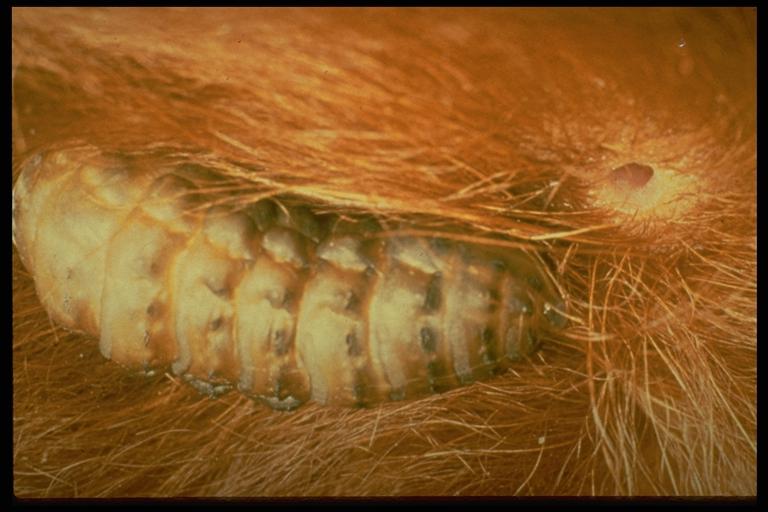
Cattle grub, Hypoderma lineatum (de Villers) (Dipetra:Oestridae), mature larva leaving host. Photo by C.L. Hoelscher.
Common Name: Cattle grub
Scientific Name: Hypoderma lineatum (de Villers)
Order: Diptera
Description: Adults are robust, black, 1/2-inch long hairy flies that have white stripes and hair tufts on the thorax. Larvae (bots) are white and grow to 1 inch long, with a pair of breathing pores (spiracles) on the back end (posterior). They turn brown to black before leaving the host to pupate.
Life Cycle: Winter is spent in the larval (bot or maggot) stage in the backs of host animals. Brown to black mature larvae, squeeze out of the hole on the animal’s back and drops to the ground where they form a pupa inside puparia made from the fifth and last larval (instar) skins during the spring (November through March). Adult flies emerge in about 5 weeks. Female flies lay rows of whitish eggs glued to hairs on the host animal, primarily around the heels, legs and lower part of the belly. Larvae hatch from eggs in 3 to 7 days and burrow under the skin. Over about a 6 month period, larvae migrate through the body to the animals back, developing through three stages (instars). There, each bot cuts a hole in the skin and places its breathing pores (posterior spiracles) nearby. It remains there for another 2 months, developing through two more larval stages (instars). There is one generation per year.
Habitat, Food Source(s), Damage: Maggots have “teasing” hook-like mouthparts; adult flies do not feed. Cattle and bison are primary hosts. Larvae hatching from eggs laid on the legs or flanks migrate beneath the skin and through the body to the gullet. They then migrate down to the diaphragm and up along the ribs to the back where they form bumpy cysts or “warbles” which cause inflammation and irritation. Larvae feed on secretions caused by the irritating presence of the maggot inside the inflamed cysts. Infestations reduce growth, milk production, and quality of meat and leather produced from infested animals. Adult flies attempting to lay eggs irritate host animals, causing cattle to run wildly and possibly injuring themselves.
Pest Status: Also called the ox bot, ox warble or heel fly, larvae (bots) develop inside cattle causing health problems (inflammation and suffering) and reducing the value of hide; adults cannot bite or sting.
Management: See Suggestions for Managing External Parasites of Texas Livestock and Poultry.
For additional information, contact your local Texas A&M AgriLife Extension Service agent or search for other state Extension offices.
Literature: Borror et al. 1989; Metcalf et al. 1962; Swan & Papp 1972.